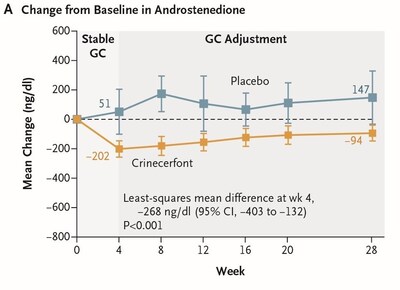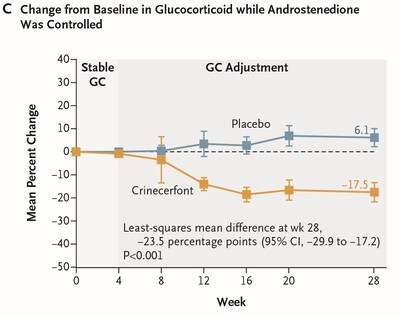Neurocrine Biosciences, Inc. (Nasdaq: NBIX) today announced that the primary study results from its CAHtalyst™ Pediatric Phase 3 study investigating crinecerfont for the treatment of congenital adrenal hyperplasia (CAH) due to 21-hydroxylase deficiency have been published in The New England Journal of Medicine online edition and will appear in a future print issue of the journal.
| - CAHtalyst™ Pediatric Study Met Primary and Key Secondary Endpoints, with Crinecerfont Treatment Decreasing Androstenedione Levels and Enabling Glucocorticoid Dose Reduction While Maintaining Androstenedione Control SAN DIEGO, June 3, 2024 /PRNewswire/ -- Neurocrine Biosciences, Inc. (Nasdaq: NBIX) today announced that the primary study results from its CAHtalyst™ Pediatric Phase 3 study investigating crinecerfont for the treatment of congenital adrenal hyperplasia (CAH) due to 21-hydroxylase deficiency have been published in The New England Journal of Medicine online edition and will appear in a future print issue of the journal. The CAHtalyst Pediatric Phase 3 study met the primary and key secondary endpoints related to androgen reduction (during an initial glucocorticoid-stable period) and glucocorticoid (GC) dose reduction while maintaining androgen control. Favorable trends were observed with endpoints that reflect the consequences of long-term supraphysiologic glucocorticoid therapy and androgen excess. In addition to appearing in The New England Journal of Medicine, CAHtalyst Pediatric Phase 3 data were presented at ENDO 2024 (Poster #SUN-441). “In treating children with CAH, from the moment they are diagnosed we are challenged with finding a balance between supraphysiologic glucocorticoid dosing and the need to prevent androgen excess. Tipping the scale too far one way or the other can adversely impact growth and pubertal development,” said Kyriakie Sarafoglou, M.D., Professor, Department of Pediatrics and Department of Experimental and Clinical Pharmacology, Divisions of Endocrinology and Genetics & Metabolism, at the University of Minnesota. “Based on the CAHtalyst Pediatric study results, crinecerfont represents a potential non-glucocorticoid therapeutic approach to meet this challenge. In addition to meeting primary and key secondary endpoints related to reducing elevated androstenedione and supraphysiologic glucocorticoid dosing during the 28-week study, treatment with crinecerfont also showed favorable trends in ameliorating the consequences of the current treatment paradigm, with reductions in body weight, improved insulin resistance, and reduced hirsutism in females.” Crinecerfont is an investigational, oral, selective corticotropin-releasing factor type 1 receptor (CRF1) antagonist being developed to reduce and control excess adrenocorticotropic hormone (ACTH) and adrenal androgens through a GC-independent mechanism for the treatment of CAH. “The outstanding results achieved in the CAHtalyst Pediatric Phase 3 study demonstrate the ability of crinecerfont to reduce elevated androstenedione levels while also enabling reduction in supraphysiologic glucocorticoid doses to more physiologic level dosing while maintaining androgen control in pediatric participants with CAH,” said Eiry W. Roberts, M.D., Chief Medical Officer at Neurocrine Biosciences. “This could potentially enable physicians to fundamentally change their approach to the important task of controlling androgens in pediatric patients with crinecerfont, without the need for long-term supraphysiologic steroid dosing, thus removing the burden that long-term excess glucocorticoid use places on development and outcome for these patients.” The CAHtalyst Pediatric Phase 3 global registrational study was conducted in 103 participants and designed to evaluate the safety, efficacy, and tolerability of crinecerfont in children and adolescents ages 2 to 17 years with CAH due to 21-hydroxylase deficiency. Over 95% of participants completed the 28-week double-blind, placebo-controlled treatment period of the study with minimal missing data. The Phase 3 Pediatric study met the primary endpoint of change from baseline in androstenedione (key adrenal androgen) following the initial 4-week GC-stable period.
After Week 4 and through Week 28, mean androstenedione remained below baseline in the context of reduced GC dose with crinecerfont but increased above baseline in the placebo group despite increased GC dose, highlighting the challenge of maintaining androgen control even with supraphysiologic GC doses in pediatric patients enrolled in this trial. The Phase 3 Pediatric study also met the key secondary endpoint of percent change from baseline in GC dose (while maintaining androstenedione control) and the secondary endpoint of achievement of reduction to a physiologic GC dose (while maintaining androstenedione control) at Week 28:
Despite the short-term duration of this Phase 3 study, favorable trends were observed for endpoints associated with long-term supraphysiologic GC therapy such as body mass index standard deviation score and insulin resistance that were encouraging considering the relatively short time frame of reduced GC dose. In addition, there was reduction in hirsutism (excessive hair growth) in female participants and improvement in the androstenedione to testosterone ratio in male participants. Crinecerfont was generally well tolerated, with the most common adverse events being headache, fever and vomiting. There were no adrenal crises in either group. Few serious adverse events occurred, with none assessed as related to crinecerfont, and there were few discontinuations due to adverse events. No events of adrenal crisis were reported during the double-blind period, and the incidence of adverse events leading to glucocorticoid stress dosing was similar in the crinecerfont and placebo groups. Note: P-values in the text and figures reflect the Journal’s convention of calculating to two significant figures. Actual P-values to three significant figures are also provided. Figures reflect observed means rather than the LSM and LSMD described in the text. Figures are from The New England Journal of Medicine, Phase 3 Trial of Crinecerfont in Pediatric Congenital Adrenal Hyperplasia, Sarafoglou K, Kim M, Lodish M, et.al. This article was published online on June 2, 2024. Copyright © 2024 Massachusetts Medical Society. Reprinted with permission from Massachusetts Medical Society. About Congenital Adrenal Hyperplasia Glucocorticoids (GCs) are currently used not only to correct the endogenous cortisol deficiency, but doses used are higher than cortisol replacement needed (supraphysiologic) to lower the levels of adrenocorticotropic hormone (ACTH) and adrenal androgens. However, glucocorticoid treatment at supraphysiologic doses has been associated with serious and significant complications of steroid excess, including metabolic issues such as weight gain and diabetes, cardiovascular disease, and osteoporosis. Additionally, long-term treatment with supraphysiologic GC doses may have psychological and cognitive impact, such as changes in mood and memory. Adrenal androgen excess has been associated with abnormal bone growth and development in pediatric patients, female health problems such as acne, excess hair growth and menstrual irregularities, testicular rest tumors in males, and fertility issues in both sexes. About Crinecerfont and the CAHtalyst™ Studies The CAHtalyst™ Pediatric and Adult Phase 3 global registrational studies are designed to evaluate the safety, efficacy, and tolerability of crinecerfont in children and adolescents, and adults respectively, with congenital adrenal hyperplasia due to 21-hydroxylase deficiency. The primary portions of the CAHtalyst Phase 3 studies have completed and enrollment is closed, while the open-label extension treatment portions of both studies are ongoing. Data from the CAHtalyst Pediatric and CAHtalyst Adult Phase 3 studies supported two New Drug Application submissions to the U.S. Food and Drug Administration in April 2024. To learn more about crinecerfont and the CAHtalyst studies, click here. About Neurocrine Biosciences, Inc. The NEUROCRINE BIOSCIENCES Logo Lockup and YOU DESERVE BRAVE SCIENCE are registered trademarks of Neurocrine Biosciences, Inc. CAHtalyst is a trademark of Neurocrine Biosciences, Inc. Forward-Looking Statements
SOURCE Neurocrine Biosciences, Inc. | ||
Company Codes: NASDAQ-NMS:NBIX |








